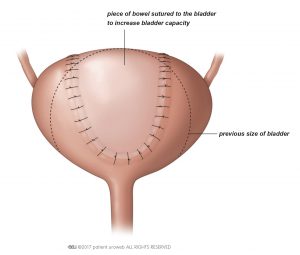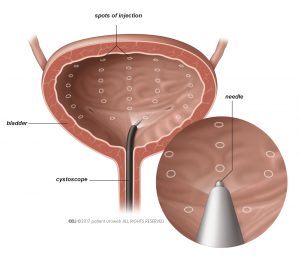Table of Contents
Sometimes the drugs your doctor prescribed do not improve your overactive bladder symptoms (OAB). In these cases, other treatment options are available. Together with your doctor you can decide which approach is best for you.
This section offers general information about second line treatment for OAB symptoms and situations can vary from country to country.
Common treatment options for OAB symptoms are:
- Botulinum toxin bladder injection
- Nerve stimulation, also known as neuromodulation
- Surgery to increase bladder volume
Botulinum toxin
Botulinum toxin is widely known by one of its trade names, Botox® and is often used in cosmetic surgery.
For OAB symptoms, the toxin is injected into the lining of the bladder to reduce the activity of the nerves which cause the symptoms. This treatment may improve urgency, frequency of urinating, and urgency incontinence.
For botulinum toxin injections, you will generally receive local anaesthesia. Sometimes other forms of anaesthesia are used. The doctor uses a type of endoscope, known as a cystoscope, to enter your bladder through the urethra. The cystoscope has a small camera to show a high-quality image of your bladder on a video monitor. The doctor injects a small dose of botulinum toxin into different areas of your bladder wall (Fig. 1).
The effect of the procedure will wear off with time and after 4-9 months you will need to undergo repeat treatment. Some people (less than 10%) may have difficulty urinating after a botulinum toxin injection, and may need a catheter. Catheters may increase the risk of urinary tract infection and your doctor may prescribe antibiotics.
Nerve stimulation
Nerve stimulation, also known as neuromodulation, is a treatment which uses electrical pulses to stimulate the sacral nerves, which control the bladder. There are two types of nerve stimulation:
- Tibial nerve stimulation uses a needle at the level of the ankle
- In sacral nerve modulation a device is implanted in your lower back
Bladder surgery
In case your symptoms have not improved with drug or other treatments, you may need surgery on your bladder. The goal of the procedure is to increase the capacity of the bladder. This will reduce the pressure in the bladder as it fills so that it can hold more urine.
The doctor makes an incision in your lower abdomen and uses a piece of your bowel to increase the size of the bladder. This procedure is called bladder augmentation or clam cystoplasty, and is rarely performed nowadays (Fig. 2). If this surgery is recommended you will need to discuss its implications and side effects with your doctor because they can be significant.



